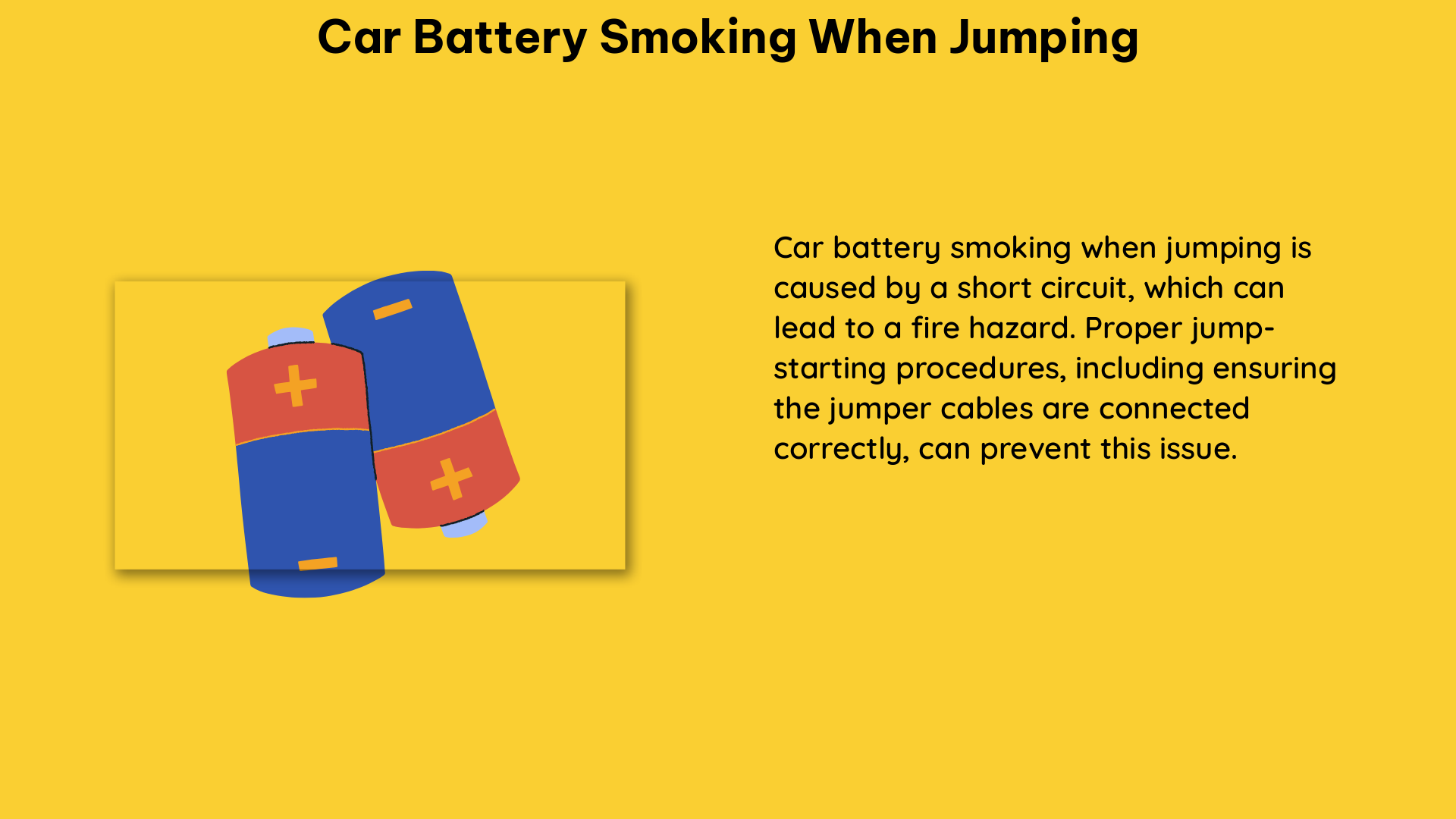Smoke coming from a car battery during the jump-starting process can be a concerning and potentially dangerous issue. This comprehensive guide will delve into the various factors that can contribute to car battery smoking, providing you with the technical knowledge and practical steps to diagnose and address this problem effectively.
Causes of Car Battery Smoking During Jumping
- High Resistance Connections:
- High resistance connections can occur at the battery terminals, the jumper cable connections, or within the car’s electrical system.
- This resistance can cause excessive heat buildup, leading to smoke and potential damage to the battery or other components.
-
Resistance can be measured using a multimeter, and values above 0.5 ohms are generally considered high.
-
Damaged Battery Cables:
- Cracks, splits, or melted/bare spots in the positive cable from the starter to the fuse box can create a high resistance path, leading to smoke.
- Damaged cables can also cause short circuits, which can result in sparking and smoke.
-
It’s crucial to visually inspect the jumper cables and the positive cable in the car’s electrical system for any signs of damage.
-
Short Circuits:
- A short circuit can occur when the positive and negative terminals of the battery are connected directly, bypassing the load (the car’s electrical system).
- This can happen if the jumper cables are connected incorrectly or if there is a fault in the car’s wiring.
-
Short circuits can cause a rapid increase in current flow, leading to overheating and smoke.
-
Overcharging:
- If the car’s charging system is malfunctioning and overcharging the battery, it can lead to excessive gas production and the potential for smoke.
- This can happen if the voltage regulator is faulty or if there is an issue with the alternator.
-
Overcharging can also cause the battery to become hot, further contributing to the risk of smoke.
-
Battery Damage:
- A damaged or worn-out battery can be more susceptible to issues during the jump-starting process.
- If the battery has internal short circuits or other defects, it may be more prone to emitting smoke when subjected to high current loads.
- Attempting to jump-start a severely damaged battery can exacerbate the problem and lead to further issues.
Diagnosing Car Battery Smoking During Jumping

- Visual Inspection:
- Carefully inspect the jumper cables for any signs of damage, such as cracks, splits, or melted/bare spots.
- Check the battery terminals and connections for corrosion, loose connections, or signs of overheating.
-
Examine the car’s positive cable from the starter to the fuse box for any visible issues.
-
Resistance Measurement:
- Use a multimeter to measure the resistance at the battery terminals, the jumper cable connections, and the positive cable in the car’s electrical system.
-
Resistance values above 0.5 ohms may indicate a high resistance connection that could contribute to smoke.
-
Battery Condition Assessment:
- If the battery is old or has been subjected to frequent deep discharges, it may be more prone to issues during jump-starting.
-
Consider having the battery tested by a professional to determine its overall health and capacity.
-
Charging System Evaluation:
- If the smoke is accompanied by signs of overcharging, such as the battery becoming excessively hot, have the car’s charging system (alternator and voltage regulator) checked by a mechanic.
Preventing and Addressing Car Battery Smoking During Jumping
- Proper Jump-Starting Procedure:
- Ensure that the jumper cables are correctly connected, with the positive (+) and negative (-) terminals properly aligned.
- Start the jump-starting process with the cars’ engines off and the parking brakes engaged.
-
Follow the manufacturer’s recommended jump-starting instructions to minimize the risk of sparks or short circuits.
-
Cable Condition Inspection:
- Thoroughly inspect the jumper cables and the positive cable in the car’s electrical system for any signs of damage, cracks, or wear.
-
Replace any damaged cables to ensure a safe and effective jump-starting process.
-
Battery Condition Monitoring:
- If the battery has been subjected to frequent deep discharges or is showing signs of age, consider replacing it to prevent future issues during jump-starting.
-
Regularly check the battery’s charge level and condition to ensure it is in good working order.
-
Charging System Maintenance:
-
Have the car’s charging system (alternator and voltage regulator) inspected and serviced by a qualified mechanic to ensure it is functioning correctly and not overcharging the battery.
-
Seek Professional Assistance:
- If the smoke persists or you are unsure of the root cause, it is best to have a qualified mechanic diagnose and address the issue to prevent further damage to the car’s electrical system.
By understanding the common causes of car battery smoking during jumping and following the recommended diagnostic and preventive measures, you can effectively address this issue and maintain the safety and reliability of your vehicle’s electrical system.
References:
- Reddit Post: Puff of Smoke from Jumping Battery
- Mechanics Stack Exchange: Lots of Sparks and Heat When Jump-Starting a Car
- AutoFactsOnline: Car Battery Starts Smoking When Jumping

The lambdageeks.com Core SME Team is a group of experienced subject matter experts from diverse scientific and technical fields including Physics, Chemistry, Technology,Electronics & Electrical Engineering, Automotive, Mechanical Engineering. Our team collaborates to create high-quality, well-researched articles on a wide range of science and technology topics for the lambdageeks.com website.
All Our Senior SME are having more than 7 Years of experience in the respective fields . They are either Working Industry Professionals or assocaited With different Universities. Refer Our Authors Page to get to know About our Core SMEs.